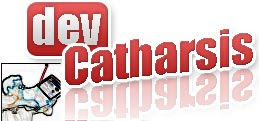Here’s a cool free book for those like me that love messing in the metaheuristics world.
Tuesday, December 22, 2009
Free book of the day: Essentials of Metaheuristics
Posted by
Mário Romano
at
Tuesday, December 22, 2009
0
comments
![]()
Labels: Education
Sunday, December 13, 2009
.NET OpenID
Here’s a cool library: DotNetOpenAuth:
This C# library adds OpenID 2.0 Provider and Relying Party, OAuth Consumer and Service Provider, and InfoCard Selectorsupport to your web site both programmatically and through convenient drop-in ASP.NET controls. Use as much or little of the functionality as you want.
Download it now
All downloads include both the library, samples, and tools to help you get started.
We use GIT for source control, click here to find out more
Features
- Compiled library that adds support for your site visitors to login with their OpenIDs by just dropping an ASP.NET control onto your page. It's that easy. An AJAX-style login control is also included for a slick, streamlined user experience.
- Give your site members their own OpenIDs with the provider support included in this library.
- Sample relying party and provider web sites show you just how to do it.
- Easy access to all the functionality so you can customize how OpenID will operate on your site, whether you use ASP.NET or not.
- Classic ASP support
- Full support for custom extensions. Plus built-in support for Simple Registration, Attribute Exchange and PAPE.
- Works in partial trusted shared hosting environments.
- Support for web farms where state persistence, front-facing web servers and ASP.NET may not be standard or even available.
- OpenID 2.0 and 1.x
- OAuth 1.0 and 1.0a
- Superior support for multi-byte Unicode identifiers.
- Lots of security features
- 490+ unit tests to verify correctness.
- Library behind the OSIS OpenID interop testing
- About 1500 downloads per month. See who's using DotNetOpenAuth
Posted by
Mário Romano
at
Sunday, December 13, 2009
0
comments
![]()
Labels: Development, Web
Wednesday, December 09, 2009
Google Chrome just got fatter
Yeap, Google Chrome now has extensions! We can say bye bye to the minimalist approach, but hello to many goodies.
Here are some of the most popular extensions – yes, there’s a basic ad blocker:
(698)
- 115,343 users
Displays the number of unread messages in your Google Mail inbox. You can also click the button to...
(327)
- 70,693 users
Blocks ads on websites. Includes the EasyList ad filter list as of 9 Dec 2009.
(180)
- 69,760 users
This extension translates entire webpages into a language of your choice with one click. By the...
(227)
- 49,322 users
Adds one-click subscription to your toolbar
(123)
- 37,235 users
Displays number of unread Waves.
(211)
- 35,478 users
Xmarks for Chrome Beta is a beta preview of Xmarks for Chrome
Please note: you’ll have to install version 4 beta.
Posted by
Mário Romano
at
Wednesday, December 09, 2009
0
comments
![]()
Labels: Web
Thursday, December 03, 2009
Windows 7 Sensor and Location Platform Overview
Uau, I want to play with this!
The Windows Sensor and Location platform, new for Windows 7, enables your computer and applications to adapt to their current environment. With location sensors -- including GPS devices, WWAN radios, and even triangulation technology -- your applications and gadgets can know exactly where they are, enabling them to provide more locally relevant content and functionality. Join Dan Polivy, Gavin Gear, product team PMs, and Yochay Kiriaty, Technical Evangelist, as they explain what the Windows 7 Sensor and Location platform is, what underlying architecture supports its functionality, and how developers can take advantage of this new and exciting platform.
Posted by
Mário Romano
at
Thursday, December 03, 2009
0
comments
![]()
Labels: Technology
Tuesday, December 01, 2009
Installing ESXi 4.0
Here are my notes on my last ESXi installation:
1. Download and burn CD from VMWare – the Dell customized version for a PowerEdge 2950
OPTIONAL BINARY
VMware ESXi 4.0 with Dell Customization
Version 4.0.0 | 181792 - 08/07/09
Binary (.iso) (417 MB)
Image for ESXi Installable that includes Dell customization.
md5sum: 0ff898e830a095abb2275181175e065e
2. Installing ESXi
Not much to say here. Basically set the password and configured the 1st network adapter.
3. Activated SSH (here’s where I’ve learned about this)
- At the console, hit ALT-F1
- type unsupported and hit <enter> (NOTE: you won’t see what your typing until you hit enter…)
- login
- edit /etc/inetd.conf
- uncomment the ssh line
- restart the services (services.sh restart)
We can now get the hell out of the datacenter :)
4. Install vSphere client
- HTTP the server, downloaded and installed vSphere client to my workstation
- On Windows 7 you have to fix it. Here the long and the short version
5. Install ftp server (here’s where I’ve learned about this)
- Downloaded OEM.tgz
- Uploaded to the datastore using the datastore browser
- On an SSH session, copied it to /bootbank/oem.tgz
- Added to /etc/inetd.conf:
- ftp stream tcp nowait root /usr/sbin/proftpd proftpd
- Reboot
And there you go, you’ve got an ftp server on your ESXi! For client ESXi has native support as:
- wget: wget ftp://user:password@source_ESXi_IP/path/file
- ftpput & ftpget
6. Install some precious tooling
- Your favorite ftp client
- VMWare Converter
Please remember:
- by default, VMWare Converter chooses flat files
- after uploading to the server your VMWare Server or Player versions, you’ll have to convert it: vmkfstools -d thin -i source.vmdk destination.vmdk.
Thanks for the support Rasteiro :)
Posted by
Mário Romano
at
Tuesday, December 01, 2009
0
comments
![]()
Labels: Operating Systems

